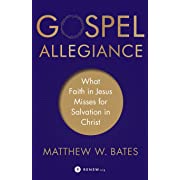 Title: Gospel Allegiance: What Faith in Jesus Misses for Salvation in Christ
Title: Gospel Allegiance: What Faith in Jesus Misses for Salvation in Christ
Author: Matthew W. Bates
Summary
Matthew Bates argues that the view of faith in the modern church has shifted to connotate something other than what the authors originally meant. According to Bates, the view of the word “faith” or “believe” (and the same words in other parts of speech) mean that we place our trust in Jesus. The view of most evangelicals is that salvation is through faith and takes no works on the believers’ part.
Bates’s primary argument is that words translated into faith or believe (pistis in Greek) would be better translated into the word “allegiance.” The author’s argument is that the Biblical authors intended for the readers to understand that faith requires a shift in mindset accompanied by showing your loyalty to the readers’ new King, Jesus.
The most notable summarization in this book would be Bates’s definition of the Gospel:
Short gospel summary: Jesus is the saving King
Expanded gospel summary: The gospel is the true story of how Jesus the Son was sent by God the Father to become the saving king who now rules forever at his right hand through the sending of the Holy Spirit, fulfilling God’s promises in Scripture.
Bates also lays out the gospel-allegiance model: The gospel is that Jesus the king
- Preexisted as God the Son,
- Was sent by the Father,
- Took on human flesh in fulfillment of God’s promises to David,
- Died for our sins in accordance with the Scriptures,
- Was buried
- Was raised on the third day in accordance with the Scriptures,
- Appeared to many witnesses,
- Is enthroned at the right hand of God as the ruling Christ,
- Has sent the Holy Spirit to his people to effect his rule, and
- Will come again as final judge to rule.
Interesting Pieces
In the introduction Bates, describes himself as a “theological mutt” (p. 21). The author also lays out the premise of the book by saying, “saving faith in the Bible intends not just belief or interior trust in God’s promises but bodily allegiance to a king. Seeing this compels us to rethink how faith, grace, and works fit together (p. 18).
Bates argues that the gospel is not the “Romans Road” (p. 34). On page 38, Bates names other preachers, pastors and authors who have not fully grasped the true allegiant gospel: John Piper, R.C. Sproul, Matt Chandler, John MacArthur, and others throughout the rest of the book, including J.D. Greear.
Bates argues that the simplest passage expressing the gospel’s content is 2 Timothy 2:8, “remember Jesus the Christ, raised from among the dead ones, of the seed of David, according to my gospel” (p. 46).
One of the primary arguments for Bates’s case is found in the second chapter, titled “Not Faith but Allegiance.” He uses the illustration of a soldier fighting in battle. A soldier expresses his loyalty to a cause or to a King by fighting for that cause and/or person. Bates argues that “Jesus the king ultimately requires one and only one thing from his subjects: loyalty” (p. 59).
On page 115, Bates admits that his definition of allegiance includes “good deeds.” On page 153, Bates argues that good works are saving. On page 178, Bates assumes that most people agree with him that good works are required for salvation. On page 198, Bates differentiates good works from works of the law being required for salvation. He says that most works of the law are not saving, but some good works are required for salvation. These are just some of the many times Bates admits that his model for salvation includes works.
Review
I believe this book is dangerous. It twists the content of the gospel into something different than what I believe was originally intended. Ephesians 2:8-10 is the most clear example of salvation and sanctification.
For by grace you have been saved through faith. And this is not your own doing; it is the gift of God, 9 not a result of works, so that no one may boast.
Paul clearly tells us that works are NOT involved in someone’s salvation here.
10 For we are his workmanship, created in Christ Jesus for good works, which God prepared beforehand, that we should walk in them.
The following verse (2:10) states that we created to good works and walk in them. These good works follow salvation, but are not included in salvation. This would place good works in the category of sanctification. It can be argued that good works are a proof of salvation, but this argument is entirely different from the argument that Matthew Bates is making. I believe Bates confuses salvation and sanctification, where I see a fine line between the moment of salvation and process of sanctification that begins the moment after salvation.
One of the biggest complaints I have with Bates’s definition of the gospel is that an individual is not required to repent from their sins. In the 10 points of the gospel, sin is only mentioned in point number four, but at no point does the individual deal the with gravity of their own sin and the consequences of that sin. The Apostle Paul says that the “wages of sin is death” (Romans 6:23). True repentance deals with our sinful nature, turning away from one thing and towards another.
Overall, the only benefit I see from this book is that it caused me to go deeper into my own beliefs surrounding salvation. I am now better equipped to defend my belief of salvation because I wanted to make sure I understood why Bates is wrong. If you are a pastor or a lay leader, I would go to great lengths to keep this book out of any parishioners’ hands.





